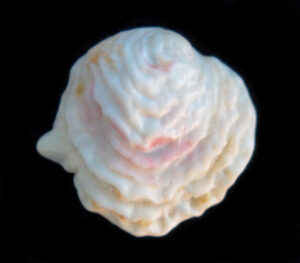Hoof Shells, which are also known as Horse Hoof Shells, are members of the Hipponicidae Family. Family members resemble Limpets, in that they have a widened cone shape but are thicker than Limpets. They derive their Family name from the horseshoe shaped muscle scar found on the shell’s interior. Their apex is located posteriorly, does not have a spiral, and it points posteriorly. The exterior of the shells are rough and layered. Some species also have radiating ribs. The shells are generally white in color; many are covered with a brown, fibrous, periostracum.
Horse Hoof Shells are found are found in a variety of habitats intertidally to depths up to 650 m (1,650 feet). Juvenile Horse Hoof Shells are mobile and move around on hard substrate. As they mature, they attach themselves to rocks, or larger shells and become sedentary. They then secrete a calcareous base plate that functions like an operculum that looks like a second valve to the shell, leading some to misidentify the shell as a bivalve. Horse Hoofs are suspension feeders, filtering detritus from the surrounding water. They are preyed upon by crabs, fish, and predatory mollusks. They are found in tropical and temperate seas worldwide. There are about sixty-three species in the Hipponicidae Family three of which are found in coastal waters of the Baja.

